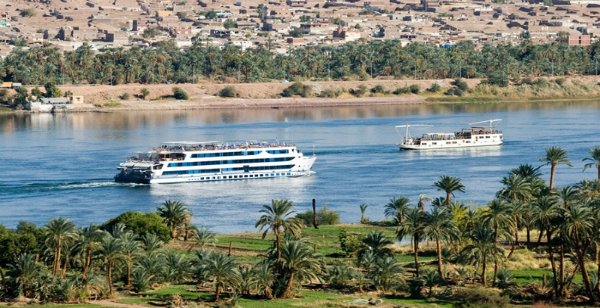Nile River Map, Location & Length from Start to End
The Nile River, the longest river in Africa and one of the world's most renowned waterways, has played a pivotal role in shaping the history, culture, and daily life of Egypt for thousands of years. Let's delve into the fascinating aspects of the Nile River, from its ancient significance to its present-day importance.
Where is the Nile River Located?
The Nile River flows through eleven countries in northeastern Africa, spanning a length of approximately 4,135 miles (6,650 kilometers). Its primary sources are the White Nile and the Blue Nile, which converge near Sudan's capital, Khartoum. From there, the river continues its journey northward, passing through Egypt before reaching its ultimate destination: the Mediterranean Sea.
Nile River Map
When you look at a map, the Nile River stands out as a lifeline running through the heart of Egypt. Originating from Lake Victoria in East Africa, the river flows northward, passing through several countries before reaching the Mediterranean Sea. Its vast network of tributaries and distributaries forms a complex system that nourishes the surrounding regions. The Nile River can be divided into two main sections: the White Nile and the Blue Nile. The White Nile, originating from Lake Victoria, merges with the Blue Nile in Sudan, near the capital city of Khartoum. From there, it continues its journey as the Nile River, flowing through Egypt until it reaches the Mediterranean.

The Nile River in Ancient Egypt
In ancient times, the Nile River was revered as the lifeblood of Egypt. It provided fertile soil for agriculture, supported the growth of civilization, and facilitated trade and transportation. The annual flooding of the Nile brought nutrient-rich silt, allowing farmers to cultivate crops and sustain a prosperous society. The ancient Egyptians regarded the Nile as a divine gift and believed it represented the cycle of life and rebirth.
The Nile Basin and Nile Valley
The Nile Basin encompasses a vast area, covering an estimated 3.4 million square kilometers. It encompasses diverse landscapes, including mountains, savannas, and wetlands. The Nile Valley, which stretches alongside the river in Egypt, is a narrow strip of fertile land that has been a focal point of civilization for millennia. The valley served as the backbone of ancient Egypt, housing major cities, temples, and agricultural lands.
The Nile River Today: A Lifeline for Modern Egypt
Even in the present day, the Nile River continues to be a lifeline for Egypt. Its waters are crucial for irrigation, supporting agriculture and sustaining the country's population. The river also serves as a vital source of freshwater for drinking and domestic use. The Aswan High Dam, constructed in the 1960s, has helped regulate the river's flow, control flooding, and generate hydroelectric power, contributing to Egypt's economic development.
The Nile River and the Mediterranean Sea
The Nile River's journey culminates at the Mediterranean Sea, forming a unique connection between the river and the sea. This convergence has had significant historical and cultural implications. The Nile Delta, located in northern Egypt, is a fertile region where the river branches out into multiple distributaries before reaching the sea. The delta's rich agricultural lands have supported human settlements and provided sustenance for generations.
The Nile River in Religious Texts
The Nile River holds spiritual and cultural significance, not only for ancient Egyptians but also in various religious texts. In the Quran, the river is mentioned as one of the signs of God's creation, symbolizing His mercy and providence. Its importance in religious narratives further emphasizes the profound impact the Nile has had on the region's history and belief systems.
Cruising on the Nile River
One of the most captivating ways to experience the Nile River is through a cruise. Nile River cruises offer a unique opportunity to witness the stunning landscapes, ancient temples, and archaeological sites that line its banks. From Luxor to Aswan, these cruises take travelers on a journey through time, unraveling the mysteries of ancient Egypt while enjoying modern comforts and luxurious amenities.
Nile River FAQs
Where is the Nile river?
The Nile River is located in northeastern Africa. It is the longest river in the world, flowing northward through eleven countries, including Egypt, Sudan, Kenya, and Uganda, before eventually emptying into the Mediterranean Sea.
How long is the Nile river?
The Nile River is approximately 6,650 kilometers (4,130 miles) long, making it the longest river in the world.
Where does the Nile river start and end?
The Nile River begins at Lake Victoria in Uganda, flowing north through several African countries, including South Sudan, Sudan, and Egypt. It ultimately ends when it empties into the Mediterranean Sea in northern Egypt.


 Italiano
Italiano
 Español
Español
